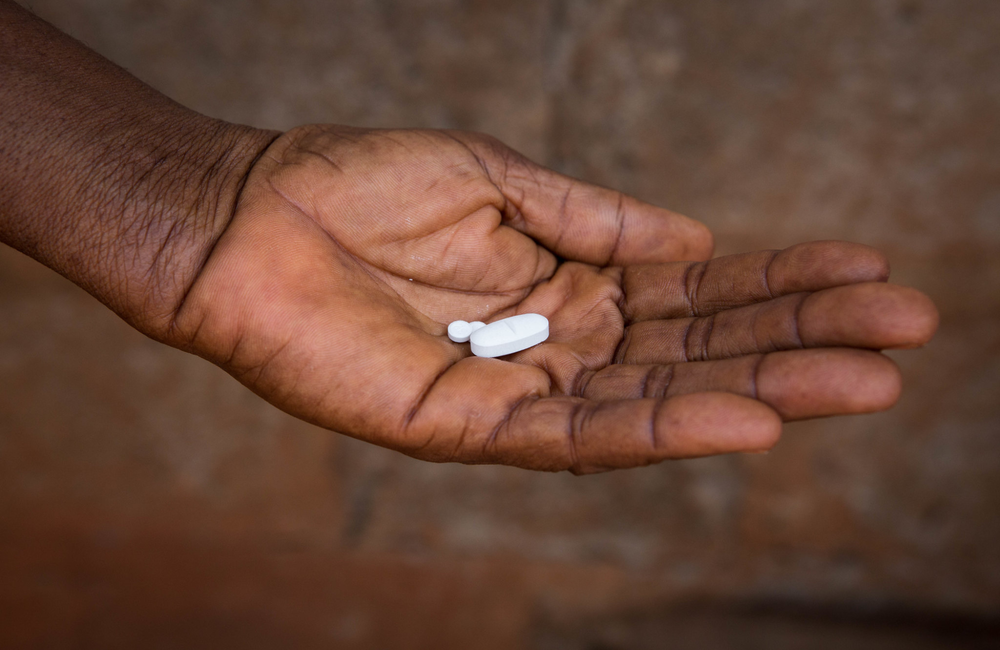
A second daily dose of dolutegravir for people taking standard TB treatment seems to be unnecessary, a South African randomised study has reported in the journal Lancet HIV.
The TB drug rifampicin can reduce levels of dolutegravir, so when dolutegravir was licensed, it was recommended that people taking dolutegravir with rifampicin should take an extra 50mg dose 12 hours after the first daily dose. As dolutegravir is almost invariably taken as part of a fixed-dose combination in settings where tuberculosis is common among people with HIV, administering a second dose requires additional dispensing of medication, a more complicated dosing pattern and higher costs.
Despite the licensing recommendation, which was based on a pharmacokinetic study in healthy volunteers, it has been unclear if the second dose is essential for maintaining adequate blood levels of dolutegravir. Even when dolutegravir is dosed once daily with rifampicin, the minimum blood level remains almost two-and-a-half times higher than the minimum level needed to reduce viral replication by 90% (the IC90).
A large retrospective study in Botswana, which looked at real-world treatment responses, showed no difference in viral load suppression between people who received one or two daily doses of dolutegravir alongside rifampicin. In this study, 44% of people received once-daily dolutegravir despite the recommendation for twice-daily dosing, a strong sign that the second daily dose is difficult to implement.
Current treatment guidelines are based on the results of INSPIRING, a phase 3b (post-licensing) randomised trial, which evaluated virological suppression in people with HIV on TB treatment randomised to receive either efavirenz or a double dose of dolutegravir. INSPIRING showed that twice-daily dosing of dolutegravir was effective.
To investigate once-daily dosing further in people taking rifampicin-based TB treatment, Professor Gary Maartens and colleagues designed the RADIANT-TB trial. The study recruited 108 people with HIV who had been diagnosed with TB and begun a standard TB treatment regimen less than three months previously. People with HIV were eligible to join the study if they had a viral load above 1,000 copies/ml, a CD4 count above 200 (later reduced to 100) and no previous treatment history or less than six months on antiretroviral treatment before interrupting treatment.
Participants were randomised eight to twelve weeks after beginning TB treatment to begin antiretroviral treatment with dolutegravir, tenofovir disoproxil and lamivudine with either one dose of dolutegravir a day as part of their fixed-dose combination, or to take a second 50mg dose of dolutegravir with food, 12 hours after their fixed-dose combination tablet. People randomised to one dose of dolutegravir also took a placebo tablet, 12 hours later. Participants took their assigned study medication throughout the 48-week study, not just when taking TB medication.
Study participants were predominantly male (65%) with a median age of 35 years. The majority (61%) had a baseline viral load above 100,000 copies/ml and the median CD4 count was 188 cells. Nineteen percent had taken antiretroviral treatment previously but had interrupted treatment. Participants had been taking TB treatment consisting of rifampicin, isoniazid, ethambutol and pyrazinamide for a median of eight weeks at the time of randomisation.
The primary study outcome was viral suppression at week 24. The proportion of participants with viral load below 50 copies/ml was identical in the two study arms (83%). As this was a non-comparative phase 2b study owing to the small number of participants that could be recruited, the parameter for evaluation was whether virological suppression in each study arm reached at least 70%. Virological suppression in both study arms exceeded the predefined margin.
Nine participants in each study arm experienced virological failure at week 24. Of these, two in the double-dose arm in three in the standard-dose arm had viral loads above 1,000 copies at week 24.
No participant with virological failure developed integrase inhibitor resistance mutations, although one participant had potential low-level resistance to raltegravir and elvitegravir at baseline and week 24.
Virological suppression at week 24 was associated with antiretroviral treatment adherence, as measured by levels of tenofovir diphosphate in dried blood spot samples at week 24 (p=0.033).
Participants took TB treatment for a median of 16 weeks after randomisation. At week 4, all participants in the double-dose dolutegravir arm had dolutegravir trough levels above the IC90 compared to 75% of the standard-dose participants (p=0.0051) but at week 24 all participants had dolutegravir trough levels above the IC90.
There was a trend towards a greater frequency of insomnia in the double-dose arm (20% vs 8%), but this side-effect reduced over time. There was no significant difference in grade 3 or 4 adverse events.
The South African researchers conclude that twice-daily dolutegravir dosing might be unnecessary but they say that more evidence from a phase 3 clinical trial or cohort studies is likely to be needed to convince policymakers to change treatment guidelines.
They caution that the results are not generalisable to people with CD4 counts below 100 or those who have experienced treatment failure, as they may have higher pre-treatment viral loads or pre-existing resistance that could compromise the response to treatment.
Writing in Lancet HIV, Dr Anushka Naidoo of CAPRISA at the University of KwaZulu Natal and Professor Kelly Dooley of Vanderbilt University Medical Center in the United States say that waiting for a phase 3 clinical trial to confirm these results will lead to “unacceptably long delays in implementing simplified dolutegravir dosing” and that double-dosing creates unnecessary costs for cash-strapped treatment programmes.
Griesel R et al. Standard-dose versus double-dose dolutegravir in HIV-associated tuberculosis in South Africa (RADIANT-TB): a phase 2, non-comparative, randomised controlled trial. Lancet HIV, published online 22 May, 2023.
https://doi.org/10.1016/S2352-3018(23)00081-4
Naidoo A, Dooley KE. Dolutegravir once daily with rifampicin for HIV and tuberculosis. Lancet HIV, published online 22 May 2023.
https://doi.org/10.1016/S2352-3018(23)00115-7
Full image credit: Fighting NTDs in Cross River State, Nigeria. Image by RTI International/Ruth McDowall. Available at www.flickr.com/photos/rtifightsntds/35590033262 under a Creative Commons licence CC BY-NC-ND 2.0.
